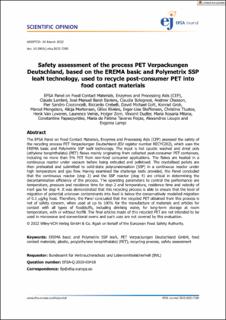| dc.contributor.author | Lambré, Claude | |
| dc.contributor.author | Barat Baviera, José Manuel | |
| dc.contributor.author | Bolognesi, Claudia | |
| dc.contributor.author | Chesson, Andrew | |
| dc.contributor.author | Cocconcelli, Pier Sandro | |
| dc.contributor.author | Crebelli, Riccardo | |
| dc.contributor.author | Gott, David Michael | |
| dc.contributor.author | Grob, Konrad | |
| dc.contributor.author | Mengelers, Marcel | |
| dc.contributor.author | Mortensen, Alicja | |
| dc.contributor.author | Rivière, Gilles | |
| dc.contributor.author | Steffensen, Inger-Lise | |
| dc.contributor.author | Tlustos, Christina | |
| dc.contributor.author | Van Loveren, Henk | |
| dc.contributor.author | Vernis, Laurence | |
| dc.contributor.author | Zorn, Holger | |
| dc.contributor.author | Dudler, Vincent | |
| dc.contributor.author | Milana, Maria Rosaria | |
| dc.contributor.author | Papaspyrides, Constantine | |
| dc.contributor.author | Tavares Poças, Maria de Fátima | |
| dc.contributor.author | Lioupis, Alexandros | |
| dc.contributor.author | Lampi, Evgenia | |
| dc.date.accessioned | 2022-09-19T08:49:13Z | |
| dc.date.available | 2022-09-19T08:49:13Z | |
| dc.date.created | 2022-05-09T10:31:35Z | |
| dc.date.issued | 2022 | |
| dc.identifier.uri | https://hdl.handle.net/11250/3018790 | |
| dc.description.abstract | The EFSA Panel on Food Contact Materials, Enzymes and Processing Aids (CEP) assessed the safety of the recycling process PET Verpackungen Deutschland (EU register number RECYC202), which uses the EREMA basic and Polymetrix SSP leaN technology. The input is hot caustic washed and dried poly(ethylene terephthalate) (PET) flakes mainly originating from collected post-consumer PET containers, including no more than 5% PET from non-food consumer applications. The flakes are heated in a continuous reactor under vacuum before being extruded and pelletised. The crystallised pellets are then preheated and submitted to solid-state polycondensation (SSP) in a continuous reactor under high temperature and gas flow. Having examined the challenge tests provided, the Panel concluded that the continuous reactor (step 2) and the SSP reactor (step 4) are critical in determining the decontamination efficiency of the process. The operating parameters to control the performance are temperature, pressure and residence time for step 2 and temperature, residence time and velocity of inert gas for step 4. It was demonstrated that this recycling process is able to ensure that the level of migration of potential unknown contaminants into food is below the conservatively modelled migration of 0.1 μg/kg food. Therefore, the Panel concluded that the recycled PET obtained from this process is not of safety concern, when used at up to 100% for the manufacture of materials and articles for contact with all types of foodstuffs, including drinking water, for long-term storage at room temperature, with or without hotfill. The final articles made of this recycled PET are not intended to be used in microwave and conventional ovens and such uses are not covered by this evaluation. | |
| dc.description.abstract | Safety assessment of the process PET Verpackungen Deutschland, based on the EREMA basic and Polymetrix SSP leaN technology, used to recycle post-consumer PET into food contact materials | |
| dc.language.iso | eng | |
| dc.publisher | European Food Safety Authority | |
| dc.relation.ispartof | EFSA Journal | |
| dc.relation.ispartofseries | EFSA Journal | |
| dc.relation.uri | https://doi.org/10.2903/j.efsa.2022.7280 | |
| dc.title | Safety assessment of the process PET Verpackungen Deutschland, based on the EREMA basic and Polymetrix SSP leaN technology, used to recycle post-consumer PET into food contact materials | |
| dc.title.alternative | Safety assessment of the process PET Verpackungen Deutschland, based on the EREMA basic and Polymetrix SSP leaN technology, used to recycle post-consumer PET into food contact materials | |
| dc.type | Research report | |
| dc.description.version | publishedVersion | |
| dc.source.pagenumber | 7280 | |
| dc.source.volume | 20 | |
| dc.source.issue | 5 | |
| dc.identifier.cristin | 2022578 | |
| cristin.ispublished | true | |
| cristin.fulltext | original | |
